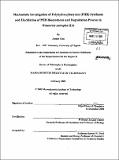| dc.contributor.advisor | JoAnne Stubbe. | en_US |
| dc.contributor.author | Tian, Jiamin, 1974- | en_US |
| dc.contributor.other | Massachusetts Institute of Technology. Dept. of Chemistry. | en_US |
| dc.date.accessioned | 2006-03-24T18:33:05Z | |
| dc.date.available | 2006-03-24T18:33:05Z | |
| dc.date.copyright | 2005 | en_US |
| dc.date.issued | 2005 | en_US |
| dc.identifier.uri | http://hdl.handle.net/1721.1/30240 | |
| dc.description | Thesis (Ph. D.)--Massachusetts Institute of Technology, Dept. of Chemistry, 2005. | en_US |
| dc.description | Includes bibliographical references. | en_US |
| dc.description.abstract | Polyhydroxyalkanoate (PHA) synthase from various bacterial organisms is able to catalyze the polymerization of (R)-hydroxyalkanoate-CoAs into high molecular weight PHAs under nutrient- limited conditions in the presence of a carbon source. PHA synthases are representative of enzymes involved in polymerizations in which a soluble substrate is transformed into an insoluble inclusion during the polymerization process. The initiation, elongation, and termination phases of this non-template driven polymerization process are not well understood. This thesis is focused on the initiation and the elongation phases leading to granule formation. For the first time, we have observed intermediate species in the in vitro reaction containing a mutant Class III synthase, D302A-PhaCPhaEAv, with its natural substrate (R)-3-hydroxybutyryl-CoA (HB-CoA). Analysis of reaction products by SDS-PAGE gel, Westerns with PHA and PhaCPhaEAv antibodies, and autoradiography showed different migratory properties of the mutant synthase after its reaction with substrate at various substrate to enzyme ratios (S/E). These results indicate that PhaCAv has been modified with hydroxybutyrate oligomers ((HB)n). The site of labeling was established to be C149, by trypsin digestion of the (HB)n modified synthase (n=3-10 at S/E = 5), reverse-phase HPLC separation of peptides, and mass spectrometry analysis. Similar intermediates have also been detected with the wild-type (wt) PhaCPhaEAv, and shown to be chemically competent. Thus, the mechanism of initiation of this synthase is through self- priming. Kinetic analysis of the reaction of HB-CoA with the wt synthase at S/E ratios of 70,000 was mechanistically informative. | en_US |
| dc.description.abstract | (cont.) The Western blots using antibodies to PhaCPhaEAv revealed the disappearance of PhaCAv (migrating as a 40 KDa protein) at early time points and the reappearance of PhaCAv as the molecular weight of the polymer approached 1 MDa. The results suggest that an inherent property of the synthase is chain termination and perhaps re- priming and re-initiation. The requirement of synthase to re-initiate in vivo has also been demonstrated by measuring the amount of PHB produced and the amount of synthase present inside the cell under defined growth conditions.Together, the in vitro and in vivo results strongly suggest that the synthase plays an important role in polymer chain termination, most likely through polymer chain transfer onto a second nucleophile that is solvent accessible. The chain can then be removed through hydrolysis, thus allowing the synthase to reinitiate new polymer synthesis. We also report the kinetic studies of PHB granule initiation and growth in W. eutropha H 16 studied with transmission electron microscopy (TEM). Analysis of the TEM images by the method of unbiased stereology provided the estimated parameters of cell volume and granule surface area per cell as a function of time. Assuming the proteins identified to be involved in PHB homeostasis are globular and are granule bound, the values of cell and granule dimensions allowed the calculation of granule surface area coverage by these proteins, whose amounts in the cell at each time point were quantitated by Western analysis. The phasin protein (PhaP) was shown to cover up to 30% of the cell surface, while the others were less than 1%. Thus, additional compounds, such as lipids, are required to cover the remainder of the surface of granules. | en_US |
| dc.description.abstract | (cont.) The TEM images at the early stages of PHB granule formation under nitrogen-limited conditions revealed dark-stained features near the center of the cells adjacent to the growing granules. These observations have led to a new model for granule formation involving some type of scaffolding. Information learned from the in vitro and in vivo studies presented in this thesis should help us in unraveling the mechanism of PHB synthases, and that of the granule formation and degradation processes. | en_US |
| dc.description.statementofresponsibility | by Jiamin Tian. | en_US |
| dc.format.extent | 2 v. (345 leaves) | en_US |
| dc.format.extent | 19650717 bytes | |
| dc.format.extent | 19698040 bytes | |
| dc.format.mimetype | application/pdf | |
| dc.format.mimetype | application/pdf | |
| dc.language.iso | eng | en_US |
| dc.publisher | Massachusetts Institute of Technology | en_US |
| dc.rights | M.I.T. theses are protected by copyright. They may be viewed from this source for any purpose, but reproduction or distribution in any format is prohibited without written permission. See provided URL for inquiries about permission. | en_US |
| dc.rights.uri | http://dspace.mit.edu/handle/1721.1/7582 | |
| dc.subject | Chemistry. | en_US |
| dc.title | Mechanistic investigation of polyhydroxybutyrate (PHB) synthases and elucidation of PHB biosynthesis and degradation process in Wautersia eutropha H16 | en_US |
| dc.type | Thesis | en_US |
| dc.description.degree | Ph.D. | en_US |
| dc.contributor.department | Massachusetts Institute of Technology. Department of Chemistry | |
| dc.identifier.oclc | 60804780 | en_US |
